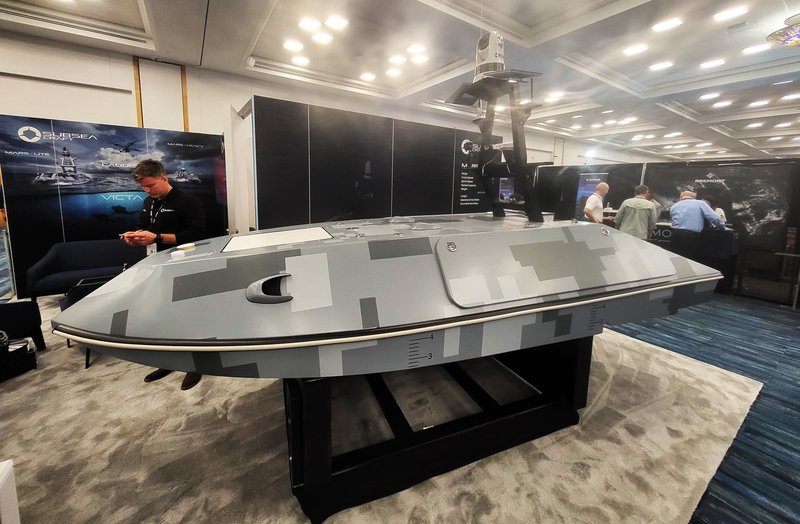SOF Week 2025: SubSea Craft introduces MARS USV
MARS USV can be deployed in contested environments (Photo: SubSea Craft)
Aiming at answering the growing international demand for unmanned surface capabilities, the Portsmouth, UK-based company SubSea Craft (SSC) showcased for the first time its new USV at SOF Week 2025.
The MARS system is designed to be a low-signature, multi-role, mission-configurable capability and provide survivability in contested environments.
“There is a clear global need for the responsive development of advanced maritime platforms that can meet evolving force requirements and objectives,” Camilla Martin, CEO of SSC, stated.
Related Articles
US Navy’s Navigation Plan 2024 to focus on rapid integration of uncrewed capabilities
US Navy seeks the best combinations of crewed vessels with commercial UAVs and USVs
NAVSEA invests more in support of mine countermeasure USVs
MARS encompasses the latest innovations in USV technology, with applications for a variety of force objectives. It can be deployed in wingman support tasks to minimise risk to manned deployments and provide a force multiplying effect.
Built to match global SOF requirements, it can also operate in ISR missions, including long-range surveillance to increase the recognised maritime picture in environments with degraded communications.
Talking to Shephard, an official for the company explained that MARS features “standard camera feeds” and “redundant comms” and can reach up to 300 nautical miles and speeds of up to 30 knots.
In terms of payloads, this USV was built to provide modular integration and carry multi-domain kinetic and non-kinetic systems.
“It is a modular craft, so it is not up for us to tell end users what they need,” SSC official remarked. “We give them shape, space and power, and then end users can put what they want in our craft.”
According to the company, the platform was taken from concept to launch in 100 days and underwent testing and validation with AUKUS partners. It included open water trials with the Australian Maritime College, which signed an R&D partnership with SSC in 2023.

“That project [to develop MARS] was a demonstration of how SubSea Craft reacts at the pace of emerging operational requirements,” the official highlighted.
“MARS has emerged as a disruptive force for the modern battlespace,” Penny Mordaunt, chair of SubSea Craft and former UK Secretary of State for Defence, stated. “Its successful testing following an impressive turnaround from its ideation is testament to SubSea Craft’s cutting-edge approach to accelerated research, development and delivery.”
VICTA diver delivery platform
MARS uses the same open architecture digital control system as SSC’s dual-domain craft VICTA, which is a next generation maritime delivery platform.
Capable of a high-speed surface transit before rapidly transitioning to a wet, subsurface mode for covert delivery of operators and/or equipment, the VICTA platform is deployable as an individual asset or as a force multiplier, enhancing maritime operations through networked, crewed or autonomous modes.
This craft has been developed through research and feedback from operators, military strategists and combat support, deployment and logistics force elements from diverse countries.
Related Equipment in Defence Insight
More from Naval Warfare
-
![US Coast Guard to receive the largest single acquisition funding in its history]()
US Coast Guard to receive the largest single acquisition funding in its history
The nearly $25 billion investment will cover USCG procurement of cutters, aircraft, helicopters, training simulators and Polar capabilities over the next four years.
-
![US Coast Guard enhances Arctic protection with a new Fast Response Cutter]()
US Coast Guard enhances Arctic protection with a new Fast Response Cutter
After commissioning, FRC Frederick Mann will operate in Alaska and perform multiple missions.
-
![Future of the US Navy’s Arleigh Burke programme remains unclear]()
Future of the US Navy’s Arleigh Burke programme remains unclear
The US Navy does not have a precise date for the award of the procurement contract for the third Arleigh Burke-class destroyer despite having the funds to advance with the programme in FY2025.
-
![US Navy may look to foreign suppliers to accelerate shipbuilding programmes]()
US Navy may look to foreign suppliers to accelerate shipbuilding programmes
The US Navy (USN) is currently reassessing its acquisition efforts and seeking ways to reduce the multiple delays across the shipbuilding initiatives.






















